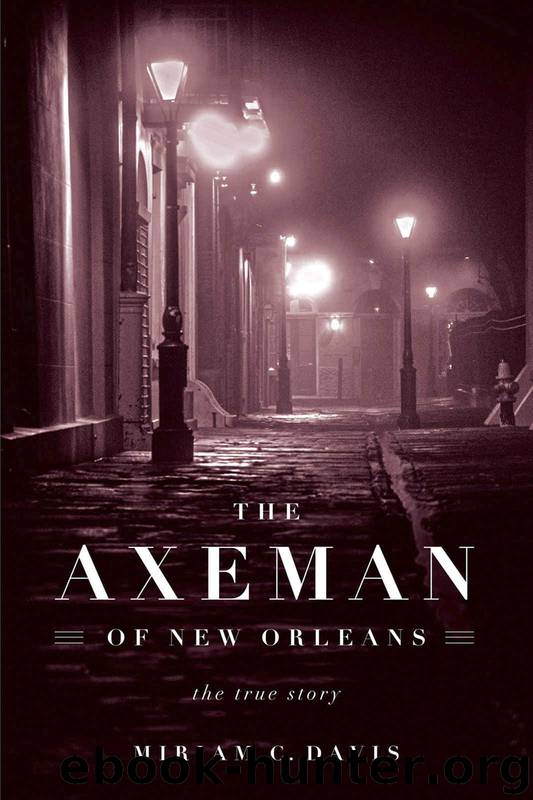Axeman of New Orleans: The True Story by Miriam C. Davis

Author:Miriam C. Davis [Davis, Miriam C.]
Language: eng
Format: azw3
Publisher: Chicago Review Press
Published: 2017-03-01T05:00:00+00:00
The Cortimiglias’ claims implicating the Jordanos were made only in front of police, not in the presence of reporters or physicians. To Dr. Landry, Rosie always denied that she knew who hit her. Medical personnel at the hospital, in fact, continued to insist that nothing the couple said could be relied upon yet. Not only was their mental condition affected by their head injuries, but the opiates they were given for pain also made their mental state unreliable. Reporters who went to see him discovered that Charlie would answer “yes” to anything he was asked.
“Did Frank Jordano attack you with an axe?” one inquired.
“Yes,” responded Charlie.
“Are you a Frenchman?” asked another.
“Yes,” came the reply.
A few days after authorities claimed that Rosie had identified Frank as her attacker, she told her doctors that she didn’t know if the man was white or black.
In fact, the so-called statements given by the Cortimiglias consisted of agreeing to highly leading questions when they probably had little idea of what they were saying:
Q: “Did Frank Jordano hit you with the axe?”
A: “Yes.”
Q: “Was Iorlando Jordano with Frank Jordano at the time he made the axe attack on you?”
A: “Yes.”
Even Sheriff Marrero admitted that Charlie “was unable to give details” but admitted to no doubts about the arrests. “I am confident we have the right men and that the Cortimiglias will recover to tell the complete story of the attack made upon them,” Sheriff Marrero assured reporters.
Frank and Iorlando’s arrest was greeted with general approval in Gretna. Popular sentiment was not on their side. Charlie Cortimiglia was an agreeable, energetic young man who was well liked in the community. Everybody knew about the quarrel over the store—if they hadn’t before, they did now—and that the deadly assault occurred shortly after the Cortimiglias had moved into their new place. The murder had badly shaken the people of Jefferson Parish, and, like the sheriff and police chief, many people found it easier to believe in revenge as a motive than they did a homicidal maniac.
Feelings against the Jordanos were so strong that some began clamoring for a special session of the grand jury to consider the case immediately. But since the chief witnesses were still in the hospital and likely to remain there for some weeks, District Attorney Rivarde vetoed the idea. It would have to wait for the regular session of the grand jury, he said, which would convene in early May.
L. Robert Rivarde was district attorney of the Twenty-Eighth Judicial District, made up of Saint Charles, Saint John, and Jefferson Parishes. He’d been a state senator and a district judge, and when Sheriff Marrero’s son Louis Jr. died in 1916, Rivarde had been selected to replace him as DA. An active member of the Marrero political machine, Rivarde could be counted on to cooperate with Sheriff Marrero in prosecuting the Jordanos.
Sheriff Marrero still had a problem. He was confident that the Jordanos were responsible for the attack on the Cortimiglias and little Mary’s death. But his witnesses were problematic.
Download
This site does not store any files on its server. We only index and link to content provided by other sites. Please contact the content providers to delete copyright contents if any and email us, we'll remove relevant links or contents immediately.
| Africa | Americas |
| Arctic & Antarctica | Asia |
| Australia & Oceania | Europe |
| Middle East | Russia |
| United States | World |
| Ancient Civilizations | Military |
| Historical Study & Educational Resources |
Cat's cradle by Kurt Vonnegut(15126)
Pimp by Iceberg Slim(14255)
4 3 2 1: A Novel by Paul Auster(12245)
Underground: A Human History of the Worlds Beneath Our Feet by Will Hunt(11992)
The Radium Girls by Kate Moore(11886)
Wiseguy by Nicholas Pileggi(5626)
Perfect Rhythm by Jae(5291)
American History Stories, Volume III (Yesterday's Classics) by Pratt Mara L(5230)
The Fire Next Time by James Baldwin(5215)
Paper Towns by Green John(5054)
Pale Blue Dot by Carl Sagan(4876)
A Higher Loyalty: Truth, Lies, and Leadership by James Comey(4813)
The Mayflower and the Pilgrims' New World by Nathaniel Philbrick(4391)
The Doomsday Machine by Daniel Ellsberg(4386)
Killers of the Flower Moon: The Osage Murders and the Birth of the FBI by David Grann(4363)
The Sympathizer by Viet Thanh Nguyen(4276)
Too Much and Not the Mood by Durga Chew-Bose(4244)
The Borden Murders by Sarah Miller(4209)
Sticky Fingers by Joe Hagan(4076)
